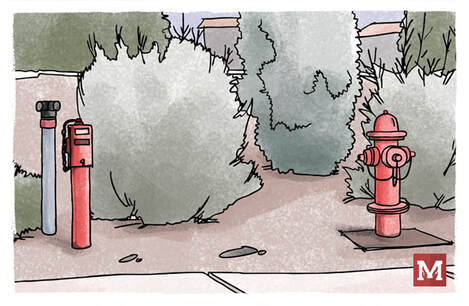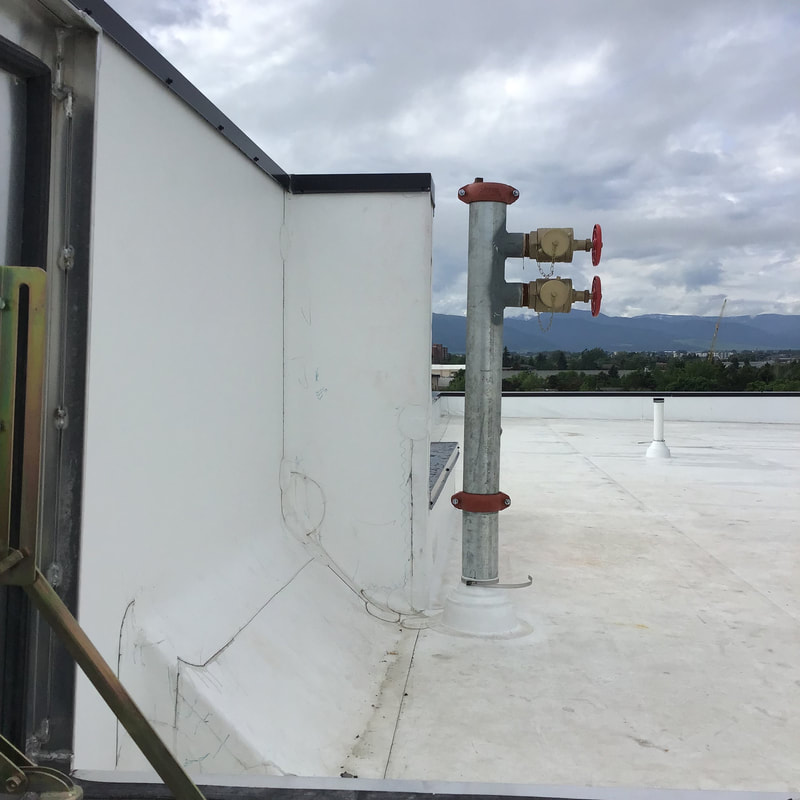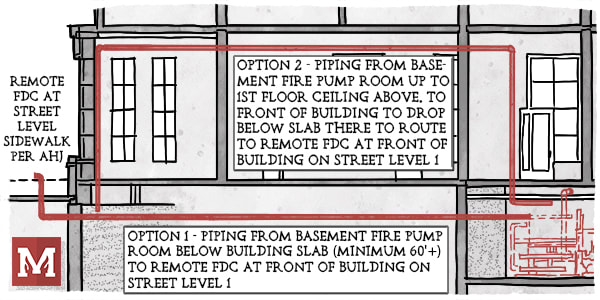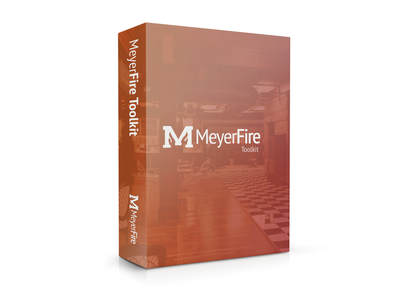|
I've always wondered, how do the responding fire personnel holding the nozzle of a hose attached to a standpipe deal with the slugs of compressed air?
What happens with a hose/nozzle when a large, class I dry manual standpipe system is getting slammed with 150 psi (or more) of water pushing all that air? Do they purge air before hooking up the hose? How about a wet manual standpipe where the FDC is several sticks of 6" pipe from the check valve? What's it like on the end of the hose when that slug of air arrives with 150-175 psi of water in front and behind it? Are there any firefighters out there experienced in standpipe operations who care to share? Sent in anonymously for discussion. Click Title to View | Submit Your Question | Subscribe
7 Comments
When are pressure reducing hose valves required on a dry automatic standpipe system?
I have a project where I have been asked to evaluate an existing sprinkler system for an 8-story apartment building. The original installation falls under NFPA 13/14/20 2013 edition. The building is served by four dry automatic standpipes and a separate wet sprinkler feed. The standpipes are not combination sprinkler/standpipes. The fire pump churn pressure is 212 psi and there is a pressure reducing valve provided for the wet system supply. There is no pressure reducing valve for the dry automatic standpipes. The hose valves on the standpipes are the pressure restricting type. Not pressure reducing. When reviewing the data sheets for the hose valves, it states "Adjustable restriction of pressures up to 175 lbs....at residual flow" but the valves themselves are rated to 300 psi. At normal, non-fire conditions, the standpipes have 23 psi static pressure of air, but if the dry valve were to trip for any reason, (non-fire or not) the standpipe exceeds 175psi static pressure on the 1st-7th floors. NFPA 14 2013 states that "7.2.3.2* Where the static pressure at a 21⁄2 in. (65 mm) hose connection exceeds 175 psi (12.1 bar), an approved pressure regulating device shall be provided to limit static and residual pressures at the outlet of the hose connection to 175 psi (12.1 bar)." Would the static pressure be considered the normal air pressure or the static pressure if the dry valve trips? My assumption here would be that the pressure restricting valve needs to be swapped for a pressure reducing type. Sent in anonymously for discussion. Click Title to View | Submit Your Question | Subscribe Does any one know in 1960's and 1970's, what the flow and pressure requirements of 1-1/2 inch standpipe system hose of NFPA 14?
This would be for a Class II system. Thanks in advance. Sent in anonymously for discussion. Click Title to View | Submit Your Question | Subscribe I have seen this method of arranging fire suppression components (see attached schematic) several times where I live. The attached is a partial re-creation of the fire water entry schematic for a high-rise building with a fire pump. The system has low and high pressure zones. The underground parking dry systems are served by the municipal water directly, and the standpipes and aboveground sprinklers are fed by the pump. Questions: 1. Can you have a FDC serving the low pressure zones as shown on the suction side of the pump per NFPA-14 6.4.3.1? 2. If not, how should the schematic be arranged instead? 3. What could happen if the Low Pressure FDC were pressurized as shown? This project was built under the 2013 editions of NFPA-13, 14, and 20. I am asking because I am beginning design of a sprinkler system for a 22 story high-rise. Thanks for your help. Sent in anonymously for discussion. Click Title to View | Submit Your Question | Subscribe For multi family buildings, I am being told that for a 4-story building, normally the fire pumps are only 15HP because the standpipes are pressurized by the fire trucks.
My understanding of NFPA 20 is that it would still be required to have a correctly sized fire pump without considering the size of the pump on the local fire trucks. Is this an industry norm that is allowed by certain AHJ’s or is there code related to multi family that I am missing? Sent in anonymously for discussion. Click Title to View | Submit Your Question | Subscribe In a 15-story highrise building, can the standpipe system be zoned with an Automatic Dry in the 1st -5th floors of the unheated Parking Garage, and an Automatic Wet in the 6th- 15th floors of the heated office portion?
Are we allowed to mix types? Sent in anonymously for discussion. Click Title to View | Submit Your Question | Subscribe Is there any requirement for a standpipe to be installed due to travel distance between stairwells in a 3-story R-2 building?
I am reviewing plans of a U-shaped apartment building with two stairwells on the ends. The distance between them is about 470 feet. We are under the 2018 IFC. If not required by code, would you as the AHJ consider requiring them for improved fire operations? Thanks for any feedback. Sent in anonymously for discussion. Click Title to View | Submit Your Question | Subscribe What is the required pressure for a manual Class III standpipe, 65 or 100 psi?
We're working on a 44'-4" high, 5-story, Type V-B construction building that has a 1-story garage and amenities. The upper floor is R-2. The local code says I can have Class III standpipe. As I go through NFPA 13 and NFPA 14, it circles back around to 2-1/2" outlets, except with 2-1/2" x 1-1/2" reducers and caps. It's going to be fully-sprinklered with a combination standpipe in one stairwell, and just one standpipe riser in the other. Does this sound correct given the project? Thanks in advance. Sent in anonymously for discussion. Click Title to View | Submit Your Question | Subscribe We're working on a one-story school. The AHJ (Fire Marshal) is requiring inside 2 1/2-inch hose valves at the exit locations.
These hose valves are fed directly off the wet sprinkler system main - not fed from a dedicated standpipe main. 1. I'm having trouble finding code regarding feeding hose valves off of the wet system main. 2. I'm trying to determine if the pipe, off the main, to these hose valves, needs a control valve installed. Appreciate the tips and insight. Sent in anonymously for discussion. Click Title to View | Submit Your Question | Subscribe Hello everyone. Looking to get some feedback on a building under construction.
I have a 3-story condo building with 4 stairwells, protected by an NFPA 13 sprinkler system. The condo building is exterior access via corridor which connects the stairwells and is about 20 units total. There is a single fire sprinkler riser that enters one of the stairwells at the corner of the building and goes vertical to serve all levels. Overall, fairly typical. Currently, the building is nearing the end of construction and they’re installing drywall. However, a new Fire Inspector is asking for “more standpipes”, despite the fact that the building does not have standpipes, nor are standpipes required (3 stories, none below grade, and below height threshold to the top floor, etc.) The reason he is requiring them is because he is saying per NFPA 14, you cannot exceed ~200 feet in between standpipes. However, because the building does not require standpipes in the first place, this code section does not seem to make sense. Of course, I know the AHJ is allowed to require things above and beyond the code but my big issue is that the building is about 80% complete now, and he asked for this on a typical inspection. The design criteria, FP shop drawings, civil plan, etc. were all approved by other inspectors/ AHJ / Reviewers, and has been for a couple of years. I noticed he seems to be intermixing the word “Standpipe” and “Fire Riser” frequently which makes conversations more difficult. Just looking for some other opinions on this issue and I appreciate any input at all. Sent in anonymously for discussion. Click Title to View | Submit Your Question | Subscribe Regarding: IFC 905.4 Location of Class I standpipe hose connections.
Class I standpipe hose connections shall be provided in all of the following locations: 1.in every required interior exit stairway, a hose connection shall be provided for each story above and below grade plane,. Hose connections shall be located at the main floor landing unless otherwise approved by the fire code official. Does this mean a standpipe connection is not needed at the ground floor? I've brought this up to numerous design/build sprinkler subs and they all say a connection is required at the ground floor. Thanks in advance. Sent in anonymously for discussion. Click Title to View | Submit Your Question | Subscribe I have a standpipe demand of 750gpm. I am providing a fire pump for the system demand.
Should I be selecting a 750 gpm pump or a 1000 gpm pump, based on adding a safety factor (or other reasoning)? My sprinkler demand is less than 750 gpm so I would only need to provide the 750 gpm for the standpipes. Thanks in advance. Sent in anonymously for discussion. Click Title to View | Submit Your Question | Subscribe We have a 3-family building with parking garage and three floors over parking for a total of four floors.
According to the IBC, a standpipe is required; my question is - is the standpipe required in all stairs? We have two stars which are less than 30-feet between the stairs. Thanks in advance. Sent in anonymously for discussion. Click Title to View | Submit Your Question | Subscribe A thread to discuss more on Post-Indicator Valve requirements from our blog hits series.
Original 2019 article link: www.meyerfire.com/blog/post-indicator-valve-required-for-my-project Are you allowed to have a valve off the standpipe feeding a hose valve that is not in the stairwell?
Working in a high rise building with two stairwells. It is dual fed with combination riser standpipes. On the tenant space there is a hose valve and they want a butterfly on the feed for the hose valve, always thought that was not allowed but couldn’t find it. Thanks in advance. Sent in anonymously for discussion. Click Title to View | Submit Your Question | Subscribe Occasionally, additional hose valve connections are required due to the failure of meeting a 150-ft / 200-ft travel distance to a hose connection.
Can you put a hose valve connection on a sprinkler system without a standpipe? How do you reflect this in a hydraulic calculation? A most-remote standpipe would require 500 gpm in a standpipe calculation. Thanks in advance. Sent in anonymously for discussion. Click Title to View | Submit Your Question | Subscribe I am currently evaluating a 7-story building that is being partially renovated and has an existing standpipe system (2 standpipes), but no sprinklers. My scope was to add sprinklers to the renovated areas, creating a partially sprinklered building.
The lack of pressure is leading the AHJ to require a fire pump due the 100 psi required for the standpipe system. While the standpipe requires the fire pump, hydrant flow tests indicate that there may be sufficient pressure to supply a sprinkler system. My question is two-fold. Is there really such a thing as a non-combined sprinkler/standpipe system where they are both required? They both get their water supply from the same source. Also, can I evaluate supplying the sprinkler system through a separate riser that tees off before the fire pump, while the fire pump supplies only the standpipe, significantly reducing the size of the pump? The pump would be sized for 750 gpm total, 500 gpm @ 100 psi to the remote hose connections, and 250 gpm to the second standpipe. What would that sprinkler calculation look like? Would the sprinkler calculation remove the hose stream allowance and replace it with the 750 gpm to consider the flow to the pump/standpipes? The flow potential is there based on the hydrant flow test just not the pressure for the standpipes (and it's close for sprinklers). I'm just wondering if I can give the client and rest of the design team options. Thanks in advance. Sent in anonymously for discussion. Click Title to View | Submit Your Question | Subscribe Is it a requirement to have a 42-inch handrail on the edge of the building, due to the standpipe hose connections and this needing to be accessible for the fire department use? If it's required, it seems that handrails could apply under IBC 2018 Section 1015.6. Thanks in advance.
Sent in anonymously for discussion. Click Title to View | Submit Your Question | Subscribe I'd appreciate some advice.
What's the best way to regulate pressures on a combined sprinkler (OH2) and Class 3 standpipe system? Obviously the pressures required vary between sprinklers, 2-1/2" standpipe outlets and 1-1/2" hose rack connections. Pressure regulating valves are expensive to put in on all connections, but I was thinking about using pressure regulating valves for the 2-1/2" standpipe outlets. I think it's great that we can all share our combined experience on this great website - thanks in advance! Sent in anonymously for discussion. Click Title to View | Submit Your Question | Subscribe I'm working with a city inspector who is adamant that we add a second non-rising stem valve (NRS) in the fire sprinkler service main just before the building. The first valve being in the street at the live-tap location with the roadway box.
Is a valve required on the service main before the building? The requested location would place the valve under the sidewalk, accessible by T-handle wrench only, prohibiting reliable supervision of any kind. I can't seem to find any language in NFPA 24 that I can use to argue against the second unsupervised valve. I don't see any value in the position the inspector has taken and requested a copy of the city ordinance requiring the additional valve. Installing the second valve wouldn't be a huge deal but certainly seems like an unnecessary opportunity for an unsupervised valve to get closed or fail. I would like to hear what others in this community think and if anyone has something to offer. Thanks in advance. Sent in anonymously for discussion. Click Title to View | Submit Your Question | Subscribe Has anyone designed a dry manual standpipe for a pier or dock standpipe system in the past?
My question is in regards to materials used for the pipe. With the tides rising and falling my client is struggling to find an approved material that will allow for enough flexibility. I walked an adjacent marina to our project and it looked like they used 4" heavy-duty rubber tubing to run out the standpipe lines and transitioned to steel only for the vertical 2 1/2" up to the hose valves on the dock. Any information to point us in the right direction would be helpful. Thanks in advance. Sent in anonymously for discussion. Click Title to View | Submit Your Question | Subscribe What does "listed for fire protection use" actually mean?
The Department of Defense specifications Section 21 13 13 calls for backflow preventers to be "listed for fire protection use". From what I have found, there is no such specific listing. Has anyone else heard of this? Thank you for your input. Hi everyone - thanks for answering my previous questions and for checking out today's as well.
I have three projects all connected to the same central fire pump assembly. It's a huge network of pipe running for miles. The client is having a problem with the fluctuating pressure (up and down) on the network for some reason that affects the fire pump's suction pressure. It's in series, and connected to each project. The client refuses to add a break tank and cut the fluctuation. In your experience, is there any alternative solution available? Would a pressure relief valve help? What would happen when the pressure is less than design? Thanks in advance! Sent in anonymously for discussion. Click Title to View | Submit Your Question | Subscribe In regards to installing pressure reducing stations for separating areas of the building into different pressure zones, NFPA 14 calls out that the FDC needs to be installed downstream of the pressure reducing valves.
Is a separate FDC required for each pressure zone? If you provide just one FDC, and the fire department supplies the system for an upper floor of a high-rise, you will exceed the maximum working pressure of the lower systems. I'm not sure how that's possible to avoid. Sent in anonymously for discussion. Click Title to View | Submit Your Question | Subscribe Can the pipe from a remote FDC at the front of our building route under the building slab to connect to our fire pump room at the back of the building? The Fire Pump Room is on the basement level. This is for a six-story hotel with a partial basement along the back portion of the building that is open to a lower grade level in back. Here's a sketch below. The fire marshal requires a remote FDC at the sidewalk in front of the building. Our fire pump room happens to be on the opposite side, in the back.
The most straightforward routing is below the building, but it is minimum 60' of run which certainly exceeds the 10' maximum distance allowed for the fire supply from NFPA 13. Going above the first floor ceiling is challenging given all the interiors/ceilings, public spaces, and glass at the street front. Given that the FDC pipe is normally-dry and not pressurized, do we have the same restrictions of 10' max below grade? Even if not, can't say I'm thrilled about having that many joints below our building above. Thanks for your help/thoughts! Sent in anonymously for discussion. Click Title to View | Submit Your Question | Subscribe |
ALL-ACCESSSUBSCRIBESubscribe and learn something new each day:
COMMUNITYTop June '24 Contributors
YOUR POSTPE EXAMGet 100 Days of Free Sample Questions right to you!
FILTERS
All
ARCHIVES
July 2024
PE PREP SERIES |
MeyerFire
- Blog
- Forum
-
THE TOOLKIT
- SUBMIT AN IDEA
- BACKFLOW DATABASE*
- CLEAN AGENT ESTIMATOR*
- CLOUD CEILING CALCULATOR
- DOMESTIC DEMAND*
- FIRE FLOW CALCULATOR*
- FIRE PUMP ANALYZER*
- FIRE PUMP DATABASE*
- FRICTION LOSS CALCULATOR
- HANGER SPACER*
- IBC TRANSLATOR*
- K-FACTOR SELECTOR*
- NFPA 13 EDITION TRANSLATOR ('19 ONLY)
- NFPA 13 EDITION TRANSLATOR ('99-'22)*
- LIQUIDS ANALYZER*
- OBSTRUCTION CALCULATOR
- OBSTRUCTIONS AGAINST WALL*
- PITOT CONVERTER
- PLUMBING FIXTURE COUNTS
- QUICK RESPONSE AREA REDUCTION
- REMOTE AREA ANALYZER*
- SPRINKLER DATABASE*
- SPRINKLER FLOW*
- SYSTEM ESTIMATOR*
- TEST & DRAIN CALCULATOR
- THRUST BLOCK CALCULATOR
- TRAPEZE CALCULATOR
- UNIT CONVERTER
- VOLUME & COMPRESSOR CALCULATOR
- WATER STORAGE*
- WATER SUPPLY (US)
- WATER SUPPLY (METRIC)
- UNIVERSITY
- PE Exam
- LOGIN
- PRICING
- OUR CAUSE

MeyerFire.com is a startup community built to help fire protection professionals shine.
Our goal is to improve fire protection practices worldwide. We promote the industry by creating helpful tools and resources, and by bringing together industry professionals to share their expertise.
MeyerFire, LLC is a NICET Recognized Training Provider and International Code Council Preferred Education Provider.
All text, images, and media Copyright © 2016-2024 MeyerFire, LLC
We respect your privacy and personal data. See our Privacy Policy and Terms of Service. The views, opinions, and information found on this site represent solely the author and do not represent the opinions of any other party, nor does the presented material assume responsibility for its use. Fire protection and life safety systems constitute a critical component for public health and safety and you should consult with a licensed professional for proper design and code adherence.
Discussions are solely for the purpose of peer review and the exchange of ideas. All comments are reviewed. Comments which do not contribute, are not relevant, are spam, or are disrespectful in nature may be removed. Information presented and opinions expressed should not be relied upon as a replacement for consulting services. Some (not all) outbound links on this website, such as Amazon links, are affiliate-based where we receive a small commission for orders placed elsewhere.

















 RSS Feed
RSS Feed
